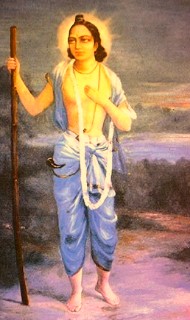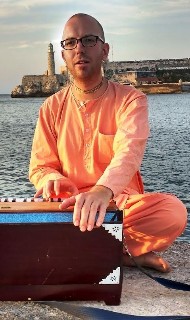Answer Podcast
Download by “right-click and save content”
The post How can we develop faith in the acharyas’ commentaries on scripture? appeared first on The Spiritual Scientist.
Websites from the ISKCON Universe
Answer Podcast
Download by “right-click and save content”
The post How can we develop faith in the acharyas’ commentaries on scripture? appeared first on The Spiritual Scientist.
Answer Podcast
Download by “right-click and save content”
The post Why do we need to read purports while reading scripture? appeared first on The Spiritual Scientist.
Answer Podcast
Download by “right-click and save content”
The post How can we balance between understanding God as a principle and loving him as a person? appeared first on The Spiritual Scientist.
Answer Podcast
Download by “right-click and save content”
The post How can we avoid becoming distracted by the uncontrolled mind? appeared first on The Spiritual Scientist.
Answer Podcast
Download by “right-click and save content”
The post How can we present scripture without compromising its truth? appeared first on The Spiritual Scientist.

Bangkok Internation Yoga Day and Ratha Yatra (Album with photos)
Kavicandra Swami: Sunday was a long day.. From 0630 we were a...

Service to Go-Mata is greater than Service to Govinda!
Sri Krishna Purusottama Das: Padma Purana: “Of all types of worship, worship of Lord Viṣṇu is best, and better than the worship of Lord Viṣṇu is the worship of His devotee, the Vaiṣṇava.”
When Pārvatī asked Lord Mahādeva, Lord Śiva, what is the best method of upāsanā, or worship, Lord Śiva answered, ārādhanānāṁ sarveṣāṁ viṣṇor ārādhanaṁ param. And further, he says that serving the associates and servants of the Lord is greater than serving the Lord directly. Mother Cow is an eternal and dear associate of the Lord, who is addressed by the prayer namo bramhanya devaya go-brahmana hitaya ca…
The Sri Govinda Gau-gram Pracar Yatra began with guidance from His Holiness Bhakti Raghava Swami Maharaja. During the first phase of this program, devotees reached 67 villages across Telangana state. As part of the second phase of this yatra, ISKCON Daiva Varnasrama Ministry (IDVM) has begun a tour of villages in Andhra Pradesh. On the first day, 22nd June 2016, Sri Harinadh Reddy, Director for Gau-Samrakshhana program of Tirumala Tirupati Devasthanams graced the occasion, joining us for a brief talk by His Grace Revati Ramana Prabhu on importance of village preaching and cow protection. His Holiness Sukadeva Goswami Maharaja blessed the program with his support, in the form of a vehicle for traveling between villages.
His Grace Revati Ramana Prabhu personally did Gau Puja and gave a brief talk before waving the green flag for the Pracar Vehicle, which headed out from Tirupati to Punganur, covering a distance of 100 kms. Punganur is a small town in Andhra Pradesh noted for the world-famous “Punganur” – a beautiful dark coloured breed of cows. Unfortunately, currently even these special cows are being sold by farmers for slaughter which is happening for beef sale in Kerala. One of the key aims of this Yatra is to educate village farmers to protect cows and increase cow-based agriculture, and to show the importance of all cow products.
On the second day, we held a mini Ratha Yatra with Sri Jagannath Baladev and Subhadra deities using a bullock cart offered by the villagers. One Mr. Krishna Reddy sponsored a function hall for a one-day village program, with Gau Puja and kirtana. During this program, we distributed more than 3000 cups of khichri and curd rice prasadam, and several pamphlets with information on cow protection. His Grace Revati Ramana prabhu gave another enlightening talk to the crowd. Reliving his childhood memories, he said he is from Bangalore , “At that time, every house in his city used to have a cow. Now, every house has a car!” He remembered a childhood instance that displayed the strong cow – human relationship. “Once, when many cows died due to a disease, the people who took care of these cows lamented beating their chests, out of separation from their cows whom them considered family. And today, the situation is so bad that farmers are sending their cows for slaughter!”
The Core team, His Grace Kirtiraja prabhu, HG Srirama Prabhu and Sri Krishna Purusottama das and team on the Sri Govinda Gau-gram Yatra delivered two video presentations on cow protection. His Grace Rupesh Chaitanya prabhu, Vice President of ISKCON Tirupati also gave a brief inspiring talk. Several local governmental officials and devotee representatives from south Indian ISKCON Temples were also present in this event. Two specialist Pancagavya doctors accompanied with HG Abhirama prabhu did check-up and Nadi Chikitsa for around 100 villagers, who received it quite appreciatively. There was a lot of activity around the book stall and cow products stalls that were set up for this event. We distributed 400 small books and cow products in this event.
On these two days, I felt Mother Cow on all sides, as everyone around was talking about cows! On behalf of the Yatra team I thank the local devotees,ISKCON IDVM, ISKCON Tirupati, His Holiness Bhakti Raghava Swami Maharaja and His Holiness Sukadeva Goswami Mahraja and His Grace Revati Ramana prabhu for this program’s success. With the blessings and prayers of devotees, the Sri Govinda Gau-gram yatra is set to achieve its goal of covering 108 villages by Gopashtami, November 2016.
 By Madhavananda Das
By Madhavananda DasWe have two choices as to which court we want to work in. The first court is that of the empowered demigod and mahājana devotee Sri Yamaraja. The second court is the court of Lord Nityananda. Working in Yamaraja's court means assisting his chief lieutenant Citragupta, whose job it is to note down all of the mistakes and sinful acts of conditioned souls. Continue reading "Fault-finding and Forgiveness
→ Dandavats"
 By Hayagriva Das
By Hayagriva Das On the 10th of June around 70 devotees coming from Montreal, Ottawa and Toronto assembled in the Buddhist Retreat Center Pho Da Son in Val-des-Monts, Canada - a perfect setting to go into seclusion for three days and dive deeply into another reality: Harinama eva kevalam - the holy name alone is everything. The participants were keen to embark on this transcendental journey under the expert guidance of Devaki Mataji, and their hearts and minds were open in order to capture insights into the secrets of chanting - in japa as well as in kirtan. Our seminar room had the perfect size so everyone could fit in comfortably, which creates a personal and confidential atmopshere. The devotees had arranged for a nice altar and Vyasasana for Srila Prabhupada, and vases with wild flowers and blossoming twigs created a devotional atmosphere. It was a perfect bhajan kutir for the following three days, to enter a transcendental journey of introspection and reflection. Continue reading "Holy Name Retreat in Canada
→ Dandavats"

Giriraj Swami: Today is the disappearance day of Srivasa Pandita, one of the members of the Panca-tattva: sri-krsna-caitanya prabhu-nityananda sri-advaita gadadhara srivasa. In describing the Caitanya tree, Sri Caitanya-caritamrta (Adi 10.8–11) states,
“The two brothers Srivasa Pandita and Sri Rama Pandita started two branches that are well known in the world. Their two brothers were named Sripati and Srinidhi. These four brothers and their servants and maidservants are considered one big branch. There is no counting the subbranches of these two branches. Sri Caitanya Mahaprabhu held congregational chanting daily at the house of Srivasa Pandita. These four brothers and their family members fully engaged in the service of Lord Caitanya. They knew no other god or goddess.”
 By Nrsimha Krsna das
By Nrsimha Krsna das We had a small summer marathon last week with International Yoga Day Celebrations and HH Sivarama Swami's visit to Istanbul. In Turkey we attended 2nd IYD Celebrations which was held in public in a campus of one of the most prestigious Universities of Turkey. Event was very well organized and Indian Consulate in Turkey also supported it as they do all over the world. You might know that Istanbul is a huge city. From one side to another city is 270 km long. So, there was many IYD events in different parts of Istanbul simultaneously. We participated in most organized one as Goranga Yoga and at the end of all yoga programs we introduced kirtan yoga to Turkish audience. Before kirtan we had a stand with books and devotional items and devotees were in devotional clothes blissfully preaching Krishna Consciousness, distributing Srila Prabhupada's books & prasadam all day. Finally when we were at the stage for chanting Maha Mantra devotees got so excited. I made a small talk about consciousness, self-realization and the nature of soul. Continue reading "A week of preaching events in Istanbul, Turkey
→ Dandavats"

Rathayatra in Puri, just a matter of days now….Potala work of 3 Rathas started… (Album with photos)
Srila Prabhupada: “My heart is always burning in the fire of material existence, and I have made no provisions for getting out of it. The only remedy is hari-nama-sankirtana, the chanting of the Hare Krishna maha-mantra, which is imported from the spiritual world, Goloka-Vrndavana. How unfortunate I am that I have no attraction for this. (Srimad-Bhagavatam, 5.1.22 Purport)
Find them here: https://goo.gl/YxF8GX

June 30. ISKCON 50 – S.Prabhupada Daily Meditations.
Satsvarupa dasa Goswami: Wisps of Remembrance , 1966.
I was thinking this morning about those persons who don’t understand the English language. I was trying to imagine what it was like. I looked at a picture of Prabhupada in 1966 and thought, “If I didn’t know what he was saying, he would be the great spiritual leader who spoke in a language I didn’t understand. Sometimes I hear the sound of his voice, but it makes no sense to me.”
Then I thought, “Oh, I would be at a great disadvantage if I couldn’t understand his language,” but then I tried to realize how hard it is not to appreciate Prabhupada as a great spiritual master. These devotees who don’t speak English have some of Prabhupada’s books translated in their languages, and although no translation can do justice to the original language in which something was written, there is no lacking.
When we walked with Prabhupada, we always tried to ensure that everything was done nicely. There should be nothing on the path that he might trip on, no low-hanging branches to possibly lash him in the face. If he needed it, there should be a car or taxi to take him where he wanted to go. There should be no inimical persons around who could harm him, and everything should run smoothly. We tried to be attentive to his every need.
When we walked with Prabhupada, the world was full of excitement and possible danger. We had to be alert with all our senses, completely absorbed in serving him as he so mildly and humbly walked through the world. Sometimes we were awkward and fumbling beside his grace. We always took pleasure in just being there with him, although there was no time for relishing that while we were walking. We were serving him, and we didn’t want our “ecstasy” to get in the way. We were happy to face anyone and anything on his behalf, and therefore, we were concerned that our appearance was neat and our mood surrendered.
To read the entire article click here: http://www.dandavats.com/?p=20490&page=9
Srivasa Pandita is one of the members of the Panca-tattva: sri-krsna-caitanya prabhu-nityananda sri-advaita gadadhara srivasa. Vedic authorities state that in the current Age of Kali, Krsna came as Sri Caitanya Mahaprabhu and Balarama came as Sri Nityananda Prabhu. Similarly, Maha-visnu appeared as Advaita Acarya, Srimati Radharani as Gadadhara Pandita, and Narada Muni as Srivasa Pandita.
Pandita is one of the members of the Panca-tattva: sri-krsna-caitanya prabhu-nityananda sri-advaita gadadhara srivasa. Vedic authorities state that in the current Age of Kali, Krsna came as Sri Caitanya Mahaprabhu and Balarama came as Sri Nityananda Prabhu. Similarly, Maha-visnu appeared as Advaita Acarya, Srimati Radharani as Gadadhara Pandita, and Narada Muni as Srivasa Pandita.
panca-tattvatmakam krsnam
bhakta-rupa-svarupakam
bhaktavataram bhaktakhyam
namami bhakta-saktikam
“I offer my obeisances unto the Supreme Lord, Krsna, who is nondifferent from His features as a devotee, devotional incarnation, devotional manifestation, pure devotee, and devotional energy.” (Cc Adi 1.14)
Panca-tattvatmakam: The Panca-tattva comprise one truth on the absolute platform. Lord Caitanya is bhakta-rupa, Krsna in the form of a devotee. Lord Nityananda is svarupakam, the expansion of a devotee. Advaita Acarya is bhaktavataram, the avatara of a devotee. Srivasa Thakura is bhakta, a devotee. And Gadadhara Pandita is bhakta-saktikam, the energy of the Supreme Lord who supplies energy to the devotees—the devotional energy, Srimati Radharani.
In the Adi-lila of Sri Caitanya-caritamrta, Srila Krsnadasa Kaviraja Gosvami describes the tree of Lord Caitanya. The tree itself is Sri Caitanya Mahaprabhu, and at the same time Sri Caitanya Mahaprabhu is the gardener who tends to the tree. This tree, like any tree, has a trunk, limbs, and branches. The limbs and branches and leaves are devotees—the devotees of Caitanya Mahaprabhu. Srila Krsnadasa Kaviraja Gosvami says that he is listing such devotees for his own purification, just to glorify them, and that he cannot distinguish between who is higher and who is lower. He wants to glorify them all. And Srila Prabhupada remarks that this is the attitude of a pure devotee. A pure devotee respects all devotees. He does not distinguish that some should be respected and some not. He respects all of them.
Srila Prabhupada also mentions that ISKCON too is a branch of the Caitanya tree. In reality, Prabhupada himself is a most important branch of the Caitanya tree, but in his humility he says that ISKCON is a branch. So all the devotees in ISKCON, who are attached to ISKCON, are leaves on the Caitanya tree. And we should respect and honor them all.
After giving us this introduction to the Caitanya tree, Srila Krsnadasa Kaviraja Gosvami begins to describe specific devotees, and the first he describes is Srivasa Thakura. For our purification, we shall read now the first verses of Sri Caitanya-caritamrta, Adi-lila, Chapter Ten, “The Trunk, Branches, and Subbranches of the Caitanya Tree.” And then we shall discuss more about Srivasa Thakura.
TEXT 1
sri-caitanya-padambhoja-
madhupebhyo namo namah
kathancid asrayad yesam
svapi tad-gandha-bhag bhavet
TRANSLATION
Let me repeatedly offer my respectful obeisances unto the beelike devotees who always taste the honey of the lotus feet of Lord Caitanya Mahaprabhu. If even a doggish nondevotee somehow takes shelter of such devotees, he enjoys the aroma of the lotus flower.
PURPORT by Srila Prabhupada
The example of a dog is very significant in this connection. A dog naturally does not become a devotee at any time, but still it is sometimes found that a dog of a devotee gradually becomes a devotee also. We have actually seen that a dog has no respect even for the tulasi plant. Indeed, a dog is especially inclined to pass urine on the tulasi plant. Therefore the dog is the number one nondevotee. But Sri Caitanya Mahaprabhu’s sankirtana movement is so strong that even a doglike nondevotee can gradually become a devotee by the association of a devotee of Lord Caitanya. Srila Sivananda Sena, a great householder devotee of Lord Caitanya Mahaprabhu, attracted a dog on the street while going to Jagannatha Puri. The dog began to follow him and ultimately went to see Caitanya Mahaprabhu and was liberated. Similarly, cats and dogs in the household of Srivasa Thakura were also liberated. Cats and dogs and other animals are not expected to become devotees, but in the association of a pure devotee they are also delivered.
COMMENT by Giriraj Swami
This is an important verse to begin the description of the Caitanya tree. The tree describes the devotees, and here Krsnadasa Kaviraja Gosvami glorifies the power of the devotees: by their power, even a doglike nondevotee can become a devotee and taste the nectar at the lotus feet of the Lord.
In six days we shall observe Jagannatha Ratha-yatra, and that date is also the disappearance day of Srila Svarupa Damodara Gosvami and Srila Sivananda Sena. Every year, Sivananda Sena would take a party of devotees from Bengal to Orissa for the Ratha-yatra, and one year a dog joined them. Sivananda Sena was so merciful that he accepted the dog as part of his party, so much so that when they had to cross a river by boat, he paid the boatman extra to induce him to take the dog.
One day, when Sivananda Sena had to attend to some work, his servant forgot to feed the dog. And when Sivananda came and inquired, “Did you feed the dog?” he discovered that it had not been given its meals. Sivananda Sena immediately sent ten men to find the dog, but they could not find it. And Sivananda Sena felt so sorry that he fasted.
The next day too they did not see the dog, but when they reached Puri they saw the dog sitting a little distance from Caitanya Mahaprabhu, who was throwing remnants of green coconut pulp to the dog and requesting the dog to chant the holy names “Hari,” “Krsna,” and “Rama.” Sivananda Sena, out of his humility, offered obeisances to the dog, feeling that he had been an offender, because he had neglected to serve the dog properly. The following day, however, no one saw the dog, for it had been liberated and gone back home, back to Godhead, by the mercy of Sri Caitanya Mahaprabhu and the holy names.
This is the strength of the mercy of a pure devotee. By the mercy of such a devotee, one gets the association of Sri Caitanya Mahaprabhu and the mercy of Sri Caitanya Mahaprabhu—the opportunity to chant the holy names of Krsna—and in the end goes back home, back to Godhead.
TEXT 2
jaya jaya sri-krsna-caitanya-nityananda
jayadvaitacandra jaya gaura-bhakta-vrnda
TRANSLATION
All glories to Lord Caitanya Mahaprabhu and Lord Nityananda! All glories to Advaita Prabhu, and all glories to the devotees of Lord Caitanya, headed by Srivasa!
TEXTS 3–6
The description of Lord Caitanya as the gardener and the tree is inconceivable. Now hear with attention about the branches of this tree. The associates of Sri Caitanya Mahaprabhu were many, but none of them should be considered lower or higher. This cannot be ascertained. All the great personalities in the line of Lord Caitanya enumerated these devotees, but they could not distinguish between the greater and the lesser. I offer my obeisances unto them as a token of respect. I request them not to consider my offenses.
TEXT 7
vande sri-krsna-caitanya-
premamara-taroh priyan
sakha-rupan bhakta-ganan
krsna-prema-phala-pradan
TRANSLATION
I offer my obeisances to all the dear devotees of Sri Caitanya Mahaprabhu, the eternal tree of love of Godhead. I offer my respects to all the branches of the tree, the devotees of the Lord who distribute the fruit of love of Godhead.
TEXT 8
srivasa pandita, ara sri-rama pandita
dui bhai—dui sakha, jagate vidita
TRANSLATION
The two brothers Srivasa Pandita and Sri Rama Pandita started two branches that are well known in the world.
PURPORT
In the Gaura-ganoddesa-dipika (90), Srivasa Pandita (Srivasa Thakura) is described as an incarnation of Narada Muni, and Sri Rama Pandita, his younger brother, is said to be an incarnation of Parvata Muni, a great friend of Narada’s. Srivasa Pandita’s wife, Malini, is celebrated as an incarnation of the nurse Ambika, who fed Lord Krsna with her breast milk, and as already noted, his niece Narayani, the mother of Thakura Vrndavana dasa, the author of Sri Caitanya-bhagavata, was the sister of Ambika in krsna-lila. We also understand from the description of Sri Caitanya-bhagavata that after Lord Caitanya Mahaprabhu’s acceptance of the sannyasa order, Srivasa Pandita left Navadvipa, possibly because of feelings of separation, and domiciled at Kumarahatta.
COMMENT
Sivananda Sena resided at Kumarahatta, and Srivasa Thakura came to live near him. Later, Vasudeva Datta also took up residence there.
Kumarahatta is a very important place. It is the birthplace of Isvara Puri, whom Sri Caitanya Mahaprabhu accepted as His guru. Sri Caitanya Mahaprabhu went there on pilgrimage and visited His guru’s birthplace, and He took dirt from the ground there and kept it in His cloth, and every day He would eat a little bit of the dirt. Sri Caitanya-bhagavata (Adi-khanda 17.98–103) describes:
“The Supreme Lord, Sri Caitanya, personally visited the birthplace of Isvara Puri. The Lord said, ‘I offer My obeisances to the village of Kumarahatta, where Sri Isvara Puri appeared.’ He cried profusely at that place and spoke nothing other than the name of Isvara Puri. He took some dust from the birthplace of Isvara Puri and tied it in His cloth. The Lord said, ‘The dust from the birthplace of Isvara Puri is My life, wealth, and living force.’ The Lord exhibited such affection for Isvara Puri, because He takes pleasure in increasing the glories of His devotees.” Even today devotees take dirt from the same place.
It is said that, following the example of Sri Caitanya Mahaprabhu, every disciple should visit the birthplace of his spiritual master. Last November, His Holiness Radhanath Swami and I visited Srila Prabhupada’s birthplace in Calcutta. Srila Prabhupada took birth under a jackfruit tree, and we visited the tree. We also saw the Deities and temple that his mother would visit. I imagined how she would pray to that Deity of Krsna for the child in her womb and how after the child’s birth she and all the relatives would pray for his well-being. Radhanath Swami and I had a wonderful experience visiting our spiritual master’s birthplace together.
TEXT 9
sripati, srinidhi—tanra dui sahodara
cari bhaira dasa-dasi, grha-parikara
TRANSLATION
Their two brothers were named Sripati and Srinidhi. These four brothers and their servants and maidservants are considered one big branch.
TEXT 10
dui sakhara upasakhaya tan-sabara ganana
yanra grhe mahaprabhura sada sankirtana
TRANSLATION
There is no counting the subbranches of these two branches. Sri Caitanya Mahaprabhu held congregational chanting daily at the house of Srivasa Pandita.
COMMENT
This sankirtana that Sri Caitanya Mahaprabhu performed at Srivasa-angana is significant. There is a parallel between the pastimes of Sri Krsna Caitanya and the pastimes of Krsna, and the nocturnal kirtan at Srivasa-angana in gaura-lila corresponds to the rasa-lila in Krsna’s pastimes. It was the highest ecstasy. To enable Caitanya Mahaprabhu and His confidential devotees to enter deeply into the kirtan and relish its mellows without disturbance, Srivasa Thakura would lock the door to his house. Only the most confidential devotees were allowed.
Prabhupada comments that to spread Krsna consciousness, when we have large-scale congregational chanting of the holy name we keep our doors open for everyone to participate, and that by the grace of Lord Caitanya Mahaprabhu this policy has brought good results. But the special kirtans held at Srivasa Thakura’s residence at night were reserved for only the most intimate devotees, so that they could freely experience and manifest their ecstasy, which could be done only in the association of devotees. A pure devotee will not do that if there are outsiders.
Srila Prabhupada’s disciple Gargamuni dasa once told Prabhupada that sometimes he felt like crying in the kirtan. Prabhupada replied, “That’s all right, because you are chanting with devotees and they will understand.” Otherwise, devotees don’t manifest such symptoms of ecstasy.
TEXT 11
cari bhai sa-vamse kare caitanyera seva
gauracandra vina nahi jane devi-deva
TRANSLATION
These four brothers and their family members fully engaged in the service of Lord Caitanya. They knew no other god or goddess.
PURPORT
Srila Narottama dasa Thakura has said, anya-devasraya nai, tomare kahinu bhai, ei bhakti parama-karana: if one wants to become a pure, staunch devotee, one should not take shelter of any of the demigods or -goddesses. . . .
COMMENT
This is an important point, especially for Hindus who are used to worshiping gods and goddesses. Sometimes even after such people come to the association of devotees and hear the philosophy of Krsna consciousness and to some extent understand it, they are reluctant to give up their worship of demigods. They may think, “Our ancestors worshiped demigods, so how can we stop?” Sometimes their deities have been passed down through generations in their family, and they are afraid that they will displease their ancestors or deities if they stop the worship—that Lord Siva or Durga or whoever will be displeased. But according to the Bhagavad-gita, one should not worship gods and goddesses. Rather, one should take full shelter of the Supreme Lord Krsna, and if one does so, the demigods too will be pleased. Lord Krsna states,
ye ’py anya-devata-bhakta
yajante sraddhayanvitah
te ’pi mam eva kaunteya
yajanty avidhi-purvakam
“Those who are devotees of other gods and who worship them with faith actually worship only Me, O son of Kunti, but they do so in a wrong way.” (Bg 9.23)
sarva-dharman parityajya
mam ekam saranam vraja
aham tvam sarva-papebhyo
moksayisyami ma sucah
“Abandon all varieties of religion and just surrender unto Me. I shall deliver you from all sinful reactions. Do not fear.” (Bg 18.66)
To engage fully in the service of Krsna or Krsna Caitanya and to know no other god or goddess is an important qualification. Krsnadasa Kaviraja Gosvami could have mentioned many other qualities of Srivasa Thakura and his family, but he specifically mentioned that they had full faith in Sri Caitanya Mahaprabhu and did not worship any devas or devis.
Five thousand years ago, Lord Krsna exhibited the pastime of lifting Govardhana Hill. The residents of Vrndavana were used to worshiping Indra, who is the king of heaven and demigod in charge of rainfall. Lord Krsna told the Vraja-vasis to take the paraphernalia that they had gathered for the indra-yajna and use it instead to worship Govardhana Hill, the cows, and the brahmanas. And because the Vraja-vasis had simple faith in Lord Krsna, they did what He said.
Due to some false pride and illusion, Indra became angry when his worship was stopped. But what was the result? Although Indra became angry and sent torrents of rain to inundate Vrndavana, Lord Krsna lifted Govardhana Hill and held it up as an umbrella to give shelter to all the residents of Vrndavana. And the result was that they were able to be with Krsna continuously for one week, 24/7. Every day, under ordinary circumstances, they would be with Him for some time but then they would be separated. In the early morning, for example, Krsna and Balarama would be with Their mother and father, but then They would go out to the fields to tend to the cows and Their parents would be separated from Them. Almost all of the residents of the Vrndavana village would be separated from Them during the day; only the cowherd boys would be with Them. But in the late afternoon when Krsna came back from the pasturing grounds, He would again enter His home and be with Nanda and Yasoda and others there, and He would be separated from the cowherd boys. Then in the middle of the night He would sneak out to meet the gopis, and then He would sneak back before His mother would come to wake Him up in the morning. And then he would be separated from the young gopis.
There was constant meeting and separation, and the separation was terrible for the Vraja-vasis, because they had such deep love for Krsna. When Krsna would return from the pasturing grounds in the late afternoon and the gopis would gaze at Him, they would curse the creator, Brahma, for creating eyelids. To the gopis, the momentary blinking of their eyes, that momentary separation from the sight of Krsna, felt like yugas, like thousands of years, because they had such intense attachment (anuraga) for Him. And so the gopis prayed to Krsna,
atati yad bhavan ahni kananam
truti yugayate tvam apasyatam
kutila-kuntalam sri-mukham ca te
jada udiksatam paksma-krd drsam
“When You go off to the forest during the day, a tiny fraction of a second becomes like a millennium for us because we cannot see You. And even when we can eagerly look upon Your beautiful face, so lovely with its adornment of curly locks, our pleasure is hindered by our eyelids, which were fashioned by the foolish creator.” (SB 10.31.15)
But during the govardhana-lila the Vraja-vasis could be with Krsna continuously. The gopis, the elder cowherd men and ladies, the cowherd boys, the servants, the animals—they all got to be with Krsna continuously. So by giving up their worship of Indra and following Krsna’s instruction to worship Govardhana Hill (which is nondifferent from Krsna) they did not lose. Rather, they gained continuous, close association with Krsna. So if we give up the worship of demigods or goddesses and take fully to the service of Krsna, we will not lose. Rather, we will gain in the most wonderful way.
Coming back to the kirtan at Srivasa Thakura’s house, because he would lock the doors, some people became angry. The Caitanya-caritamrta describes that, being excluded, some of these nonbelievers (pasandis) burned with envy and plotted against Srivasa Thakura. The leader of the nonbelievers was a brahmana named Gopala Capala, and he assembled paraphernalia for the worship of the goddess Bhavani (Durga) and placed it outside Srivasa Thakura’s door to defame him, because generally the worshipers of the goddess Bhavani, Durga, or Kali, are considered lower class. They drink wine and eat meat. For a Vaisnava, such things are anathema. So Gopala Capala wanted to defame Srivasa Thakura, and alongside the paraphernalia for the worship he placed a pot of wine.
In the morning, when Srivasa Thakura opened the door and saw all the paraphernalia, he immediately called for the respectable gentlemen of the neighborhood. He told them, “Just see, here is the paraphernalia for the worship of Bhavani.” There was a banana leaf and some rice and red sandalwood paste—and the jug of wine. He said, “Every night I worship the goddess Bhavani. Now all you respectable gentlemen can understand my actual position—who I really am—and you can take whatever action you deem fit.”
Of course, the respectable brahmanas and other members of the higher castes could understand what had happened, that some envious person had wanted to defame Srivasa Thakura and desecrate his house. So they called for a sweeper (in Bengali a hadi) to dispose of all of those untouchable things and purify the place by mopping it with a mixture of water and cow dung.
Three day later, Gopala Capala was afflicted with leprosy. Blood oozed from sores all over his body, and germs and insects attacked him. Such is the position of a devotee: one who offends any devotee suffers. And that is also the Lord’s mercy. By punishing the offender He simultaneously protects His devotees from further offenses and prevents the offender from committing more offenses. He helps the offender realize his mistake and make progress in spiritual life. So Gopala Capala was burning with leprosy, suffering unbearable pain.
One day when Caitanya Mahaprabhu passed nearby, Gopala Capala appealed to Him, “You are an incarnation of God. You have come to deliver the fallen souls. I am very fallen and wretched. So please deliver me.” Of course, it is true that Caitanya Mahaprabhu came to deliver the fallen souls, but He really came to deliver them from material existence altogether—not from any particular condition—by distributing the holy name and krsna-prema. Srila Narottama dasa Thakura, a great devotee, prayed,
golokera prema-dhana, hari-nama-sankirtana,
rati na janmilo kene taya
samsara-visanale, diva-nisi hiya jvale
judaite na koinu upaya
“The treasure of divine love in Goloka Vrndavana has descended as the congregational chanting of Lord Hari’s holy names. Why did my attraction for that chanting never come about? Day and night my heart burns in the fire of the poison of worldliness, and I have not accepted the means for relieving it.”
vrajendra-nandana yei, saci-suta hoilo sei,
balarama hoilo nitai
dina-hina yata chilo, hari-name uddharilo,
tara saksi jagai-madhai
“Lord Krsna, the son of the King of Vraja, became the son of Saci, and Balarama became Nitai. The holy name delivered all those souls who were lowly and wretched. The two sinners Jagai and Madhai are evidence of this.”
Lord Caitanya brought chanting of the holy name—the treasure of krsna-prema—and delivered all who were sinful and fallen, even Jagai and Madhai. Although this Gopala Capala was very sinful and insulting, it seems that he had one good quality: he was simple. He accepted Sri Caitanya Mahaprabhu as the Supreme Personality of Godhead and had faith that He could deliver him. So he appealed to Caitanya Mahaprabhu, and Mahaprabhu called him a sinner and told him, “Because of your sins, you are suffering.” And that is a fact: whatever suffering we experience in this world is due to our sins. The Bhakti-rasamrta-sindhu explains that suffering is due to sin and that sin is due to ignorance. Thus the only way to really become free from suffering is to become free from sin and ignorance—in other words, to become enlightened in transcendental knowledge, engage in devotional service, and ultimately go back to Godhead.
Caitanya Mahaprabhu told him, “You are envious of pure devotees. That is the worst sin. I shall not deliver you. Rather, I shall see you bitten by these germs for millions of years. For your offense against Srivasa Thakura, you will fall into hellish conditions for millions of lifetimes. He is My pure devotee.” After some time passed, Gopala Capala actually took shelter of Sri Caitanya Mahaprabhu, and the Lord mercifully instructed him, “If you approach Srivasa Thakura and get his mercy—and if you do not commit such sins again—you will be freed from the effects of your offenses.” And that is the only way to be relieved from vaisnava-aparadha. It is the recommended way and the fastest way—to go to the Vaisnava you have offended, throw yourself at his feet, and beg for forgiveness. Gopala Capala did that. He took shelter of the lotus feet of Srivasa Thakura, and by Srivasa’s mercy he was freed from all sinful reactions.
Then there was another person, a brahmacari who practiced austerities and ate only milk and fruits. Repeatedly, daily, he begged Srivasa Pandita, “Please allow me to witness the sankirtana in your house at night. I will be ever grateful to you.” Repeatedly he begged and pleaded, and finally Srivasa Pandita relented: “I know you are a good soul. You are a strict brahmacari and eat only fruit and milk. I think you are eligible to see the Lord’s dancing, but you will have to remain hidden, because the Lord has ordered that no one be allowed in the house.”
Srivasa Pandita secretly brought the brahmacari inside the house and hid him. During the kirtan, Lord Caitanya and His other associates chanted and danced, but they did not experience their usual ecstasy. Soon the Lord remarked, “Today I do not feel the same ecstasy while dancing. Perhaps someone is hiding inside the house. Please tell the truth.”
Srivasa Pandita became afraid and said, “My Lord, I assure you that there are no nonbelievers in the house—only a brahmacari, a qualified, sinless brahmana who eats only milk and fruits. He had a strong desire to see You dance. Still, You are right, my Lord. He is hiding here.”
The Lord became furious and said, “Take him out of this house immediately. What is his qualification to see My dancing? How can one develop devotion to Me simply by drinking milk?” The Lord declared, “Just by drinking milk no one can attain Me. A person may be renunciant without mundane attachment, but if he does not surrender to Me I do not accept him. On the other hand, even a low-caste dog-eater who takes full shelter of Me I accept.”
By now the brahmacari was trembling with fear, and he came out of hiding. Still, he thought, “I was so fortune to see the Lord dance. And now I am receiving the appropriate punishment.” He accepted the Lord’s chastisement as mercy. And the Lord, understanding the brahmacari’s heart, blessed him. He told him, “Do not try to attain power through penances and austerities. Rather, render loving service unto the Supreme Lord Krsna. That is the highest activity.” And the Lord placed His lotus feet on the brahmacari’s head.
Another brahmana came to witness the kirtan at Srivasa-angana, but because the door was locked he could not enter, and he returned home disappointed. The next day he met Caitanya Mahaprabhu, broke his brahmana’s thread, and cursed Him: “You will never enjoy material happiness.” When Lord Caitanya heard this curse, He felt great jubilation. He took it as a blessing: “I will be free of material enjoyment.”
As mentioned earlier, even the cats and dogs in Srivasa Thakura’s house were delivered. In Caitanya-bhagavata, after Caitanya Mahaprabhu heard Srivasa Thakura speak with great faith and love for Nityananda Prabhu, He blessed him, “Everyone in your household, including your pet dogs and cats, will find complete shelter in My devotional service.”
Srivasa Thakura had a Muslim tailor. (We also have a Muslim tailor, Abdul, at our Juhu temple, and he sews our cloth.) This tailor stayed near Srivasa-angana and used to sew garments for Srivasa Thakura and his family. One day the tailor saw Caitanya Mahaprabhu dancing. Caitanya Mahaprabhu chanted and danced in ecstasy not only in His private kirtans but on other occasions as well, and the tailor, seeing the Lord’s dancing, became enchanted. Lord Caitanya understood the tailor’s mind and mercifully showed him His original form as Krsna. Then the tailor began to shout, “Dekhinu! Dekhinu! I have seen! I have seen!” In ecstatic love, he danced with Caitanya Mahaprabhu. And he became a first-class Vaisnava and prominent devotee of Sri Caitanya Mahaprabhu.
Anyone who takes shelter of Sri Caitanya Mahaprabhu can be delivered. It does not matter if one is a brahmana, a brahmacari, a milk-drinker, a meat-eater, a yavana, a Muslim. These are not qualifications or disqualifications. Anyone who takes shelter of Caitanya Mahaprabhu or, better yet, His devotee (the tailor was a servant of Srivasa Pandita) can get the mercy of Sri Caitanya Mahaprabhu and obtain love for Krsna.
Sri Caitanya Mahaprabhu, in His ecstatic mood, asked Srivasa Thakura, “Please bring My flute”—because He was in the mood of Krsna. But Srivasa replied, “The gopis have stolen it.” When Caitanya Mahaprabhu heard this, He became ecstatic. He said, “Please say more. Please say more.” Srivasa Thakura began to describe the mellows of Krsna’s Vrndavana pastimes, and Caitanya Mahaprabhu said, “Please say more. Please say more.” Then Srivasa Thakura described more—how Krsna played on His flute and the gopis wandered in the Vrndavana forest, and how Krsna celebrated the rasa dance and played in the Yamuna. “Please say more. Please say more.” Srivasa spoke more and more about the mellows and pastimes of Krsna in Vrndavana, especially the rasa-lila. Thus the two of them passed the entire night, and when morning came, Sri Caitanya Mahaprabhu embraced Srivasa Thakura and Srivasa was satisfied.
These are some of the earlier pastimes, when Sri Caitanya Mahaprabhu resided in Navadvipa. As stated, eventually Sri Caitanya Mahaprabhu took sannyasa, left Navadvipa, and settled in Jagannatha Puri, and Srivasa Thakura, in separation from Caitanya Mahaprabhu, moved to Kumarahatta.
Every year, Sivananda Sena would lead a party of devotees from Bengal to Orissa to meet Caitanya Mahaprabhu, participate in the Ratha-yatra, and stay with Him for the four months of the rainy season, caturmasya. One year, Srivasa Thakura observed the Hera-pancami festival with Caitanya Mahaprabhu and Svarupa Damodara Gosvami. Hera-pancami is a very special festival. Two weeks before Ratha-yatra is Snana-yatra, the public bathing of Lord Jagannatha, after which Lord Jagannatha retires to His private quarters and for two weeks does not see His devotees. It is said that He catches a cold from the Snana-yatra, and so for two weeks His wife Laksmi, the goddess of fortune, serves Him faithfully, giving Him special drinks and infusions, represented by fruit juice, to help Him recover and feel better.
After two weeks, Lord Jagannatha, feeling separation from His other devotees, takes permission from Laksmi to go out. Really, He wants to meet and reciprocate with His devotees in Vrndavana. So, in the Ratha-yatra, He proceeds on His chariot from Nilacala, which is like Dvaraka (or Kuruksetra), down the road to Sundaracala, to the Gundica temple, which is considered to be Vrndavana.
The day before the Ratha-yatra is Gundica-marjana, during which Caitanya Mahaprabhu and His devotees thoroughly clean the Gundica temple to make it fit to receive the Lord. And the next day is the Ratha-yatra procession. Then, for about eight days, Lord Jagannatha stays in the Gundica temple. But after four or five days Laksmi becomes impatient: “Where is my husband? He said He was just going out for a ride. Where is He? He should be back.” Restless and angry, she takes her maidservants and travels to Sundaracala in her own procession. At the gate of the Gundica temple, she sends her maidservants to arrest the principal servants of Lord Jagannatha, which they do. They bind the servants around the waist and make them fall down at her lotus feet. And they berate the servants, making them the butt of jokes and loose language.
During this pastime, Sri Caitanya Mahaprabhu, Svarupa Damodara Gosvami, and Srivasa Thakura had a discussion. Srivasa Thakura, as the incarnation of Narada Muni, a great devotee of Lord Narayana in Vaikuntha, became ecstatic seeing the opulence of the goddess of fortune, the eternal consort of Lord Narayana. He told Svarupa Damodara, “Just see how opulent my goddess of fortune is. Vrndavana’s opulence consists of a few flowers and twigs, some minerals from the hills, and a few peacock feathers. When Jagannatha was in Vrndavana, Laksmi wondered, ‘Why did Lord Jagannatha give up so much opulence and go to Vrndavana?’ Then, to make Him a laughingstock, she decorated herself and brought her maidservants to deride Him and His servants. Finally, His servants submitted to her and promised to bring Lord Jagannatha before her the very next day, and the goddess of fortune, being pacified, returned to her apartment.” Thus Srivasa Thakura joked with Svarupa Damodara, as described in Sri Caitanya-caritamrta (Madhya 14. 213–215):
amara laksmira sampad—vakya-agocara
“ ‘Just see! My goddess of fortune is opulent beyond all description.
dugdha auti’ dadhi mathe tomara gopi-gane
amara thakurani vaise ratna-simhasane
“ ‘Your gopis are engaged in boiling milk and churning yogurt, but my mistress, the goddess of fortune, sits on a throne made of jewels and gems.’
arada-prakrti srivasa kare parihasa
suni’ hase mahaprabhura yata nija-dasa
“Srivasa Thakura, who was enjoying the mood of Narada Muni, thus made jokes. Hearing him, all the personal servants of Sri Caitanya Mahaprabhu began to smile.”
Then Sri Caitanya Mahaprabhu Himself spoke.
prabhu kahe,—srivasa, tomate narada-svabhava
aisvarya-bhave tomate, isvara-prabhava
“Sri Caitanya Mahaprabhu told Srivasa Thakura, ‘My dear Srivasa, your nature is exactly like that of Narada Muni. The Supreme Personality of Godhead’s opulence is having a direct influence upon you.
inho damodara-svarupa-suddha-vrajavasi
aisvarya na jane inho suddha-preme bhasi’
“ ‘Svarupa Damodara is a pure devotee of Vrndavana. He does not even know what opulence is, for he is simply absorbed in pure devotional service.’ ” (Cc Madhya 14.216–217)
Then Svarupa Damodara Gosvami, who is an incarnation of the gopi Lalita-devi, one of Srimati Radharani’s most confidential girlfriends, glorified Vrndavana’s opulence. He said that the natural opulence of Vrndavana is like an ocean and that the opulence of Dvaraka and Vaikuntha cannot be compared even to a drop. He said that Krsna is the Supreme Personality of Godhead, full in all opulences, and that His opulences are fully manifest only in Vrndavana. He paraphrased and elaborated upon a verse from Sri Brahma-samhita (5.29):
cintamani-prakara-sadmasu kalpa-vrksa-
laksavrtesu surabhir abhipalayantam
laksmi-sahasra-sata-sambhrama-sevyamanam
govindam adi-purusam tam aham bhajami
“I worship Govinda, the primeval Lord, the first progenitor, who is tending the cows, yielding all desire, in abodes built with spiritual gems, surrounded by millions of purpose trees, always served with great reverence and affection by hundreds of thousands of laksmis, or gopis.” Govinda, Krsna, the cowherd boy, is served by hundreds of thousands of laksmis in the form of gopis. In fact, these gopis are considered super laksmis. The laksmis in Vaikuntha are only expansions of these gopis. In Vrndavana, the houses and land are made of cintamani stones; the trees are kalpa-vrksas, wish-fulfilling desire trees; and the cows are surabhis, who deliver oceans of nectar-like milk.
Svarupa Damodara then quoted a related verse by Bilvamangala Thakura, to glorify the opulence of the gopis and Vrndavana:
cintamanis carana-bhusanam angananam
srngara-puspa-taravas taravah suranam
vrndavane vraja-dhanam nanu kama-dhenu-
vrndani ceti sukha-sindhur aho vibhutih
“The anklets on the damsels of Vraja-bhumi are made of cintamani stone. The trees are wish-fulfilling trees, and they produce flowers with which the gopis decorate themselves. There are also wish-fulfilling cows, which deliver unlimited quantities of milk. These cows constitute the wealth of Vrndavana. Thus Vrndavana’s opulence is blissfully exhibited.” (Brs 2.1.173, Cc Madhya 14, 228)
And he quoted another verse from Sri Brahma-samhita (5.29):
sriyah kantah kantah parama-purusah kalpa-taravo
druma bhumis cintamani-gana-mayi toyam amrtam
katha ganam natyam gamanam api vamsi priya-sakhi
cid-anandam jyotih param api tad asvadyam api ca
“The damsels of Vrndavana, the gopis, are super goddesses of fortune. The enjoyer in Vrndavana is the Supreme Personality of Godhead, Krsna. The trees there are all wish-fulfilling trees, and the land is made of transcendental touchstone. The water is all nectar, the talking is singing, the walking is dancing, and the constant companion of Krsna is His flute. The effulgence of transcendental bliss is experienced everywhere. Therefore Vrndavana-dhama is the only relishable abode.” (Bs 5.56, Cc Madhya 14.227)
Actually, the opulence of Vrndavana is greater than that of Vaikuntha. But the special quality of Vrndavana is that its opulence is covered by an exquisite sweetness that is so powerful that the pure devotees in Vrndavana forget that Krsna is God. They don’t even think He is God. In Vaikuntha the devotees are aware of the Lord’s opulence and worship Him with awe and veneration. They act as His servants (dasya-rasa) or at most as reverential friends (gaurava-sakhya-rasa). In Vaikuntha there is no sense of equality with the Lord, but in Vrndavana the devotees are able to enjoy ecstatic, intimate relationships with Krsna, with full freedom, because they forget that He is God.
If the residents of Vrndavana were conscious that Krsna is God, the cowherd boys could never play with Him as equals like they do. Sometimes Krsna and the cowherd boys compete in sport, and if Krsna loses He has to carry the other boy on His shoulders. This is unheard of in Vaikuntha; it would cause a scandal. If someone got up on Lord Narayana’s shoulders, he would immediately be expelled from Vaikuntha. And Krsna’s parents, Nanda and Yasoda, and others in the parental mood, such as Ambika, feel that Krsna is dependent on them. Ambika is Krsna’s nurse in Vrndavana; she suckles Krsna. And Malini, Srivasa Thakura’s wife, is her incarnation. So she has that maternal mood. Such devotees, in vatsalya-rasa, feel that they have to take care of Krsna. The cowherd boys feel that they are Krsna’s equals, His friends, and the elders feel like they are Krsna’s parents and guardians, that Krsna is dependent on their care and protection.
In fact, Krsna is providing everything for everyone. Nityo nityanam cetanas cetananam: He is the singular eternal one among so many eternal beings, and He is the singular conscious entity among so many conscious entities. Eko bahunam yo vidadhati kaman: He is the one, singular, eternal conscious being who is providing all the necessities and fulfilling all the desires of the many, plural, eternal conscious beings. He is providing for everyone, but still Mother Yasoda is thinking, “He is my son. If I don’t feed Him, He will starve.” She can think that way because her attachment for Him as a mother for her son is stronger than her awareness of His divine opulence. Most of the time she forgets; she is not even conscious that He is the Lord. And most of the time, the residents of Vrndavana forget.
Sometimes Krsna enacts deeds that remind them of His godly opulence, such as when He lifted Govardhana Hill. After He did so, the elder cowherd men were confused and approached Nanda Maharaja: “Your Krsna is no ordinary boy. He lifted a great mountain and held it in one hand for seven days. And as a mere infant, He sucked out the life of the powerful demoness Putana. And He killed many powerful demons and performed many wonderful feats. He is no ordinary person. He might be a demigod—or even Lord Narayana Himself.” They weren’t sure. “Still,” they continued, “we have constant affection for your son—and He has natural attraction for us.” They were bewildered. But when they thought of Krsna’s humanlike pastimes, they became overwhelmed with parental affection. They thought of all the times He had become frightened, the times He had felt hungry, the times He had done mischief. And they remembered how He had become happy when they coddled Him and sad or angry when they neglected Him. Thinking of Krsna’s childlike, humanlike behavior (nara-lila), they became overwhelmed with parental affection and forgot His divine opulence.
Once, Mother Yasoda looked into Krsna’s mouth. Krsna and Balarama were playing with Their friends, and all the boys joined with Balarama to complain to Mother Yasoda that Krsna had eaten earth. Sometimes, when children are at a certain age, they put anything into their mouths. Krsna said, “No, mother. They are lying.” Yasoda replied, “But even Your brother Balarama says that You ate dirt.” Krsna said, “He is lying too. But if you have any doubt, you can look.” “All right. Open Your mouth. I will see.”
So Krsna opened His mouth, and Mother Yasoda looked inside, and there she saw the entire cosmic manifestation. She saw all moving and nonmoving entities, all directions, the material elements, the sky and stars and planetary systems. She saw the living entities, the modes of nature, time, and karma. She saw everything. She even saw herself and the land of Vraja. And she was struck with doubt and wonder. Was she dreaming, or hallucinating, or being mystified by some illusion of the material nature, perhaps created by the demigods? Or was she having some vision caused her son’s mystic power? “All right,” she said. “Close Your mouth. Just don’t do it again.” Even then, she still thought of Krsna as her son. Although Krsna is always full in all opulences, His display of opulence does not diminish His pure devotees’ love for Him—as a son or a friend or a beloved. That is vraja-bhakti.
In this discussion with Srivasa Pandita, Svarupa Damodara glorified the opulence of Vrndavana, but that opulence is covered by the sweetness of these intimate relationships, in which the devotees forget that Krsna is God and to reciprocate with His devotees’ love, Krsna also forgets that He is God. When Mother Yasoda lifts a stick to Krsna and Krsna becomes afraid, He is not pretending. He actually feels like a child, and He feels afraid. In Queen Kunti’s prayers, she remarks that she sees the image of Krsna with Mother Yasoda standing with ropes to bind Him: Krsna is crying, and His tears are washing the mascara around His eyes. The same Krsna who is feared by fear personified is afraid of Mother Yasoda. And thinking of this contradiction, Kunti becomes bewildered.
gopy adade tvayi krtagasi dama tavad
ya te dasasru-kalilanjana-sambhramaksam
vaktram niniya bhaya-bhavanaya sthitasya
sa mam vimohayati bhir api yad bibheti
“My dear Krsna, Yasoda took up a rope to bind You when You committed an offense, and Your perturbed eyes overflooded with tears, which washed the mascara from Your eyes. And You were afraid, though fear personified is afraid of You. This sight is bewildering to me.” (SB 1.8.31)
These are elevated, transcendental topics, not easy to understand. Although we may have theoretical knowledge, we still tend to identify with the body and act on the bodily platform—“I” and “mine.” And these topics are on the spiritual platform. Still, hearing these topics is the process of purification. By offenseless hearing of the Lord’s activities, even without complete understanding, we can become purified and attracted. And we want to be attracted, to desire to serve in Caitanya Mahaprabhu’s pastimes, and ultimately in Krsna’s pastimes. We do not want to remain bound to temporary, material affairs and engrossed in ephemeral, mundane relationships.
One night, during the kirtan at Srivasa-angana, a calamity took place. One of Srivasa Pandita’s sons, who had been ill, died. Naturally, Srivasa’s wife, Malini, and others were distraught, but Srivasa said, “Keep quiet. We must not disturb Mahaprabhu’s kirtan.” So nobody cried or said anything. After the kirtan was over, Sri Caitanya Mahaprabhu (who is God and knows everything) said, “There must have been some calamity here.” When Srivasa told him, “My son died,” Sri Caitanya replied, “Why did you not tell Me earlier?” He went to the place where the son was lying dead and asked him, “Why are you leaving Srivasa Thakura’s home?” The son replied, “I stayed here as long as my destiny allowed. Now that the time is over, I must proceed to my next destination, according to Your order. I am Your eternal servant, a dependent living being, and I move by Your desire.”
By this exchange between Sri Caitanya Mahaprabhu and Srivasa Pandita’s dead son, everyone in the household was enlightened with spiritual knowledge. There was no cause for lamentation. They realized the knowledge of the Bhagavad-gita (2.13):
dehino ’smin yatha dehe
kaumaram yauvanam jara
tatha dehantara-praptir
dhiras tatra na muhyati
“As the embodied soul continuously passes, in this body, from boyhood to youth to old age, the soul similarly passes into another body at death. A sober person is not bewildered by such a change.” Actually, everyone changes his or her body even in the same lifetime. Just as one has a baby’s body, then a youth’s body, and eventually an old person’s body, similarly, at the time of death, one accepts another body. And dhiras tatra na muhyati: the sober are not bewildered by such a change.
The body is like dress. Just as one discards old and useless garment and puts on a new one, similarly, when the body is old and useless, the soul leaves it and takes on a new body.
vasamsi jirnani yatha vihaya
navani grhnati naro ’parani
tatha sarirani vihaya jirnany
anyani samyati navani dehi
“As a person puts on new garments, giving up old ones, the soul similarly accepts new material bodies, giving up the old and useless ones.” (Bg 2.22)
Ultimately, everything is under the control of the Lord, and all the more so in the case of devotees. Everything and everyone is under the control of the Lord, and these principles were manifested in the exchange between the dead son of Srivasa Pandita and his eternal Lord and master, Sri Caitanya Mahaprabhu.
Then Caitanya Mahaprabhu told Srivasa Pandita (and Malini), “You have lost one son, but Nitai and I are your eternal sons. And We shall never leave you.” Malini is Ambika in krsna-lila, so she is in the mood of a mother, or nurse. But whoever we may be, if we just surrender to Krsna and offer everything to Him, we will not lose. Rather, we will gain unlimitedly. Srivasa and Malini lost one son, who was encaged in a temporary, miserable body, but they gained two sons who are eternal.
Srila Prabhupada advises that instead of being absorbed in these temporary relationships that last only as long as the body (at most), we should rather develop our relationship with Krsna, or Sri Krsna Caitanya, which is eternal, blissful, and full of knowledge. This relationship develops by offenseless chanting and hearing of the holy names and pastimes of the Lord. Offenseless, attentive chanting cleanses the dust from the mirror of the mind (ceto-darpana-marjanam), and thus one is able to realize one’s constitutional position as an eternal servant of Krsna, an eternal servant of Krsna Caitanya Mahaprabhu. One still does one’s duties in the world—that is another thing—but one gives one’s heart to Krsna, to one’s relationship with Krsna, and realizes eternal, blissful, spiritual love.
jnane prayasam udapasya namanta eva
jivanti san-mukharitam bhavadiya-vartam
sthane sthitah sruti-gatam tanu-van-manobhir
ye prayaso ’jita jito ’py asi tais tri-lokyam
[Lord Brahma said to Krsna,] “Those who, even while remaining situated in their established social positions, throw away the process of speculative knowledge and with their body, words, and mind offer all respects to descriptions of Your personality and activities, dedicating their lives to these narrations, which are vibrated by You personally and by Your pure devotees, certainly conquer Your Lordship, although You are otherwise unconquerable by anyone within the three worlds.” (SB 10.14.3)
Caitanya Mahaprabhu noticed that Srivasa Thakura never went to earn anything for his family’s maintenance. So one day He asked, “Srivasa, I see that you never go anywhere. How will you maintain your family?” Srivasa replied, “I do not want to go anywhere.” Mahaprabhu said, “But you have a big family. What will happen to them?” “Whatever is destined will come,” he replied. “If that is your mentality,” Mahaprabhu said, “then you should take sannyasa.” “I am not ready for sannyasa,” Srivasa objected. “I do not have the power to take sannyasa.” “Then how will you maintain your family?” Mahaprabhu asked. “These days, if you do not make some effort, nothing will come. Then what will you do?” Srivasa clapped his hands thrice and said, “One. Two. Three.” Mahaprabhu asked, “What does that mean?” Srivasa Thakura replied, “If for three days no food comes and I have to fast, I will tie a rock around my neck and drown myself in the Ganges.”
When Caitanya Mahaprabhu heard this He became agitated and roared, “Srivasa, what are you saying? Why should you fast three times? Have you forgotten My words in the Bhagavad-gita (9.22)—ananyas cintayanto mam ye janah paryupasate/ tesam nityabhiyuktanam yoga-ksemam vahamy aham: ‘Those who always worship Me with exclusive devotion, meditating on My transcendental form—to them I carry what they lack, and I preserve what they have’? Not even once will you be lacking. Even if the goddess of fortune herself becomes poverty-stricken—even if she becomes a beggar—your house will never know want. I will personally bring whatever you need.”
Of course, what the Lord says in the Gita is true—though such constant concentration on Krsna is not so easy. But if one does come to the stage of always meditating on Krsna without deviation, the Lord will arrange whatever one needs. In that stage, one depends completely on the mercy of the Lord. Ye yatha mam prapadyante tams tathaiva bhajamy aham—as people surrender to Krsna, He rewards them accordingly. If one thinks, “I will make my own arrangement,” the Lord will think, “All right, he’s making his own arrangement, so I need not worry about him.” The Lord reciprocates according to our degree of surrender.
It could be said that previously the culture was more conducive to a brahminical way of life, and that is true, but still, what Lord Caitanya said is also true.
There is a famous story of a brahmana who was reading the Bhagavad-gita, and when he came to the verse in which Krsna says, “To those who concentrate on Me exclusively, I preserve what they have and carry what they lack (yoga-ksemam vahamy aham),” he thought, “Well, no. Krsna might send it through somebody, but He will not come personally.” (Caitanya Mahaprabhu told Srivasa Thakura, “I will come personally if need be.”)
ananyas cintayanto mam
ye janah paryupasate
tesam nityabhiyuktanam
yoga-ksemam vahamy aham
“Those who always worship Me with exclusive devotion, meditating on My transcendental form—to them I carry what they lack, and I preserve what they have.” (Bg 9.22)
When the brahmana came to the words vahamy aham, “I carry,” he scratched them out with a red ink. He did not believe that Krsna would personally carry what the devotee requires.
Later, the brahmana went out to beg alms. There are different ways by which brahmanas maintain themselves, and one is to go out and beg alms. So, while he was gone, a young boy came to the house with a rod across his shoulders, and suspended from the ends of the rod were baskets full of rice, dal, flour, ghee, vegetables—everything. It was such a heavy load that the boy could hardly carry it. He barely managed to reach the door. The lady of the house, the brahmani, asked, “Who are you?” He said, “Your husband sent me. I have brought all these ingredients for you. He will be coming soon. Please cook a nice feast for him. He will be hungry.” She cooked a big feast and invited the boy to stay. But the boy replied, “No, if I take too long, your husband becomes angry with me, so I will have to go.” And when he turned to leave, she saw slashes on his back—wound marks—which were red with blood.
Eventually the husband returned, dejected. He said, “I tried all day, and not one person gave me anything. I did not get even one grain of rice. Today we shall have to fast.” She said, “No, you sent that boy with so many provisions. I have already cooked a big feast.” “No, I didn’t send any boy.” “You did. He brought all these ingredients. But when I asked him to stay, he said that if he delays you will become angry with him. He already had wounds from you on his back.”
The brahmana thought of the Bhagavad-gita. He looked in his copy to where he had cut the words vahamy aham, and he saw that the red ink was gone. Then he knew: “That boy was Krsna.” The Bhagavad-gita is the Lord Himself. By cutting those words in the Gita, he had cut the body of the Lord. And he understood that Krsna, true to His word, had come personally and carried what His devotee lacked (yoga-ksemam vahamy aham).
That is a high level of Krsna consciousness—to always be absorbed in Krsna, without deviation—but that is our goal. And the more we have faith in Krsna, the more we will be able to chant and hear about Krsna with exclusive attention. We won’t be distracted, worrying, “From where will the money come? How will we pay the bills?”—or whatever—so many anxieties. As we develop more faith in Krsna, we are able to surrender more, to Krsna and the process of bhakti-yoga, to chanting and hearing the holy name and glories of the Lord and serving the Lord’s devotees. We are confident that Krsna will take care of us.
Devotees never go hungry. Once, many years ago, I asked a senior disciple of Srila Prabhupada, “Krsna consciousness is so nice—just chanting, dancing, feasting, and philosophy, with no anxiety—is there any austerity? What is the austerity?” And he replied, “The austerity is that there is too much to eat. To honor the prasada and to please the devotees, we may have to eat more than we want.”
We have much to learn from the example of Srivasa Thakura, from his dealings with Sri Caitanya Mahaprabhu and His devotees. And we have much to learn from all the members of the Panca-tattva, and from all the devotees of Caitanya Mahaprabhu—from the branches, subbranches, and leaves of the Caitanya tree, including the present members of ISKCON, Srila Prabhupada’s spiritual family and transcendental household.
Sri Srivasa Thakura ki jaya!
Srila Prabhupada ki jaya!
Gaura-bhakta-vrnda ki jaya!
Nitai-gaura-premanande hari-haribol!
[A talk by Giriraj Swami on Srivasa Pandita’s disappearance day, June 28, 2008, Moorpark, California]
 Giriraj Swami read and spoke from Srimad-Bhagavatam 4.30.35 during a Skype conversation with devotees in Mumbai.
Giriraj Swami read and spoke from Srimad-Bhagavatam 4.30.35 during a Skype conversation with devotees in Mumbai.
“Translation: Whenever pure topics of the transcendental world are discussed, the members of the audience forget all kinds of material hankerings, at least for the time being. Not only that, but they are no longer envious of one another, nor do they suffer from anxiety or fear.
Purport: Vaikuntha means “without anxiety,” and the material world means full of anxiety. As stated by Prahlada Maharaja, sada samudvigna-dhiyam asad-grahat: the living entities who have accepted this material world as a residence are full of anxiety. A place immediately becomes Vaikuntha whenever the holy topics of the Personality of Godhead are discussed by pure devotees. This is the process of sravanam kirtanam visnoh, chanting and hearing about the Supreme Lord, Visnu. As the Supreme Lord Himself confirms:
naham tisthami vaikunthe
yoginam hrdayesu va
tatra tisthami narada
yatra gayanti mad-bhaktah
“My dear Narada, actually I do not reside in My abode, Vaikuntha, nor do I reside within the hearts of the yogis, but I reside in that place where My pure devotees chant My holy name and discuss My form, pastimes and qualities.” Because of the presence of the Lord in the form of the transcendental vibration, the Vaikuntha atmosphere is evoked. This atmosphere is without fear and anxiety. One living entity does not fear another. (SB 4.30.35)
(Kadamba Kanana Swami, Untitled Lecture)
The quality of humility and the quality of being able to develop love of God come together. It is not possible to develop love of God if there is no humility in our hearts. A person who is proud, how can he hear!? His ears are blocked because he is overwhelmed by his own ideas that he cannot even hear what everyone else says. But if one is humble, then one can think, ‘Yes, I need mercy.’
 So a humble personality is eager to hear and being eager to hear from superior personalities also brings about special dynamics. When people are eager to hear then the mature vaisnava who speaks opens up his heart. He will automatically, by the eagerness of the audience, become very enthusiastic and he will find that there are so many realizations in his heart that he did not even know he had! Because in the relationship between vaisnavas, the mood is very intimate and close and one of deep friendship; a mood of acceptance. An envious person cannot accept.
So a humble personality is eager to hear and being eager to hear from superior personalities also brings about special dynamics. When people are eager to hear then the mature vaisnava who speaks opens up his heart. He will automatically, by the eagerness of the audience, become very enthusiastic and he will find that there are so many realizations in his heart that he did not even know he had! Because in the relationship between vaisnavas, the mood is very intimate and close and one of deep friendship; a mood of acceptance. An envious person cannot accept.
An envious person will always find some reason not to accept others, he will always find some quality that is not allowed, something wrong, ‘You can’t sit like that, you can’t look like that, you can’t speak like that…’ and so on and so on. Just on some external feature, an envious person will reject. Basically anyone who is not supporting them, adoring them, recognizing their greatness – such persons are undesirable.
So humility is the quality where one is ready to see good in others and recognizes that everyone can make a contribution which can be appreciated. So amongst vaisnavas there is an atmosphere of appreciation.
They say that as we age, time seems to pass faster. They say that when you’re having fun time seems to pass faster. Whether we are getting older, having lots of fun, or both, this school year has surely seemed to pass real fast! It was a year of new beginnings, with new administration team, some new teachers, new students, and several new extra curricular classes. It was a year of revision and improvement. A year of hard work with a dedicated team of teachers, parents and students. A successful year.
We marked the end of this school year with our traditional annual ceremony at the temple, in the presence of the deities and devotees.
The youngest students opened the ceremony by chanting the bhajan “Nadia Godrume”. The Middle Elementary class recited the key verses of Bhagavad-gita and their translations (mostly through songs), which they have learned throughout this year. The Upper Elementary class chanted the Brahma Samhita prayers they learned along with their translations.
Next we had each student receive a certificate, appreciating one of the outstanding qualities they exhibited during the year. In turn, they each shared some of their highlights, experiences which stood out for them, or the most exciting thing they have learned this year.
We concluded the ceremony with our latest promotional video, created by Bhismadeva Prabhu, which is included in this newsletter.
New students are knocking on our doors for the next school year. Much work is awaiting us this summer and we look very much forward to yet another wonderful year together.

Part 1 FINDING OUR MATERIAL SELVES TO HELP US FIND OUR SPIRITUAL SELF: I have thought and written much about what it takes to stay the course in bhakti for our whole life, as well as to how not to settle into a comfortable religious life not intensely focused on making spiritual advancement. They are related subjects though usually spoken of separately. I am thinking mostly about what kind of unique guidance should be provided devotees of different ages, needs, and personality types.
Everyone is best served by tailor-made guidance which takes into consideration a person’s age, years of spiritual practice, material necessity and nature, and all-around maturity. I bring up the topic because most of us didn’t receive this type of guidance and suffered accordingly. I am challenged to succinctly present this in the bite size form of a blog, as there are so many aspects to consider, so please take this as food for thought to be expanded upon.
When I and those of my generation lived in ashrams during our young and inexperienced years some of us just plugged into the bhakti process without really understanding our nature and if we could live primarily spiritually focused for the long haul. To learn how to center our lives totally on active seva is valuable, though it’s often unsustainable due to our surfacing desires and conditioning. This should be made clear to every new devotee, so they don’t feel guilty if they have to leave the ashram, or need to address some pressing concern in their marriage.
In the world’s great wisdom-traditions, prayers are often acknowledged as means for accessing divine power. The prayers by saints often reveal the profound depths of their selfless devotion to God.
One such exalted prayer is the song Markine Bhagavata-dharma (Teaching Krishna consciousness in America) that Srila Prabhupada composed in 1965 while he was aboard the Jaladuta, the ship that had carried him from India to America. However, the ship had only been the physical instrument – what had actually carried him across the ocean was his selfless aspiration to share Krishna’s message of spiritual love with the world. That aspiration had inspired him to embark in the advanced years of his life on a bold journey, alone and penniless. And his journey had turned out to be much more demanding than any normal ship journey. After being initially discomfited by seasickness, he had been afflicted on two successive nights with two devastating heart attacks, which he had to endure without any medical assistance whatsoever. Having weathered both the stormy seas and the deadly heart attacks, he had finally, after a thirty-five-day voyage, reached the coast of America.
On beholding the American coastline, Srila Prabhupada used his mother tongue Bengali to express his heart’s innermost thoughts and emotions in an intimately direct appeal to Krishna. Revealingly, even these spontaneous expressions are rooted in scripture. This natural link between his personal expression and scriptural revelation is evident in his quoting a series of Sanskrit verses from Srimad-Bhagavatam, a devotional classic that is considered one of the most important books in the Sanskrit canon. This is the book whose translation and commentary was to become his life’s magnum opus – a multi-volume rendition whose first three volumes he was carrying with him. These volumes comprise the transcendental arsenal with which he aspired to dissipate the worldly illusions of his audience.
Let’s look verse-by-verse at the meaning and mood of Srila Prabhupada’s prayer-song.
History would soon be testimony to how well-placed Srila Prabhupada’s faith was – within a decade, millions the world over started chanting the holy names, hearing bhagavata-katha and discovering the inexhaustible happiness of spiritual love.
The post “Make me dance” – Meditation on Srila Prabhupada’s prayer on beholding the American coastline appeared first on The Spiritual Scientist.

Urgent Appeal!
Indradyumna Swami: Dear Devotees! Woodstock 2016 is just around the corner. We are short on manpower this year and require at least 100 more devotees to help us in Krsna’s Village Of Peace. We need devotees willing to serve selflessly in the kitchen, distributing prasadam, driving vans, cleaning, security, cleanup and many other practical services.
The mood of our village is to give our guests the opportunity experience the joy of Krsna consciousness. We work hard behind the scenes. But there will be plenty of time for devotee helpers to also participate in the daily Ratha Yatras and the Kirtan Tent – where Madhava prabhu, Bada Haridas, Mahatma, Sri Prahlada, myself and others will be leading non-stop kirtans.
The organizers are expecting 750,000 people. Our village is very safe, secure and clean. Our accommodation is very simple; we sleep in classrooms in local schools which we rent for the week.
The dates for Woodstock are July 13 - 17. The festival is held in Kostrzyn, Poland only 2 hours drive from Berlin, Germany. We can arrange to pick you up in Berlin ( and return you there after the festival ) but we are unable to pay transportation from your home city.
We are especially appealing to European devotees who do not require a visa to Poland; devotees from the Baltics, the Balkans, Hungary, the UK, Germany, Italy, France, Spain, the Netherlands etc. We have 600 confirmed devotees coming, but again, we require at least 100 more. It will be extremely difficult for us unless we get that help.
Krsna’s Village of Peace Woodstock is a preaching program of epic proportions. We will distribute prasadam to just under 200,000 people ( 45 tons of Bhoga ) do Ratha Yatra through the crowds each day and introduce the tens of thousands of people who visit our village to Krsna consciousness through kirtan, theaters, yoga, questions and answers tents, etc.
We will be celebrating our 26th year at Woodstock. Rumors are this may be the last Woodstock so please consider joining us for a spiritual experience of a lifetime.
Photos in this album are all from our village during Woodstock 2015 to give you an idea of the event.
If you are interested to join us, or have any questions, please write to me personally at:
Indradyumna.swami@gmail.com
Your servant,
Indradyumna Swami
Read more: https://goo.gl/dDTSrX

TV report of the yoga world day in Radhadesh, Belgium (2 min video)
On the occasion of World Day of Yoga, fans were able to enjoy many free sessions. Durbuy example where followers are addicted to relaxing postures and evasion in the gardens of the Château de Petite Somme.
Watch it here: http://goo.gl/ujgFPI
 By Rasananda das
By Rasananda das Proper sankirtan – a phrase used by Srila Bhaktisiddhanta Saraswati in his Sri Sanmodana Bhasyam and by Lord Caitanya Himself - means certain tunes, certain instruments, a certain musical style, certain dress and certain kinds of dancing by the members of the chanting party. In Caitanya Mahaprabhu’s sankirtan movement, rathayatra and the kirtan that is its soul are for distributing the benediction of the Lord’s own process for spiritual emancipation to the onlookers and participants alike. Understanding this, when sincere organizers of a rathayatra or sankirtan party see to it that the rath and the kirtan are proper, what to speak of people, even the birds and animals that hear and witness it can immediately experience spiritual happiness. Only some impersonalists and hardened atheists present might fail to experience the Lord’s benediction. On the other hand, Kirtan not according to the rules may succeed in entertaining onlookers but being not according to the principles and practices of acaryas and experienced devotees, the greatest result - transformation from spiritual somnolescence to a state of spiritual awakening, of actual Krishna consciousness - will not result. Such kirtans simply lack the potency to enact such transformation. Srila Saraswati Thakur therefore says that kirtan, if it is not proper, is not actually. Continue reading "Kirtan: Are there rules?
→ Dandavats"

Paris Ratha-yatra 2016 (4 min video)
At the Paris Ratha-yatra, we had a beautiful four-hour procession with enthusiastic partic...
The post A day after my flying out of Istanbul terrorists strike there appeared first on SivaramaSwami.com.
 By Yudhistir Govinda Das
By Yudhistir Govinda Das You may be glad to learn that a week ago the Government of India appointed Rasaraja Prabhu (Dr. Ravi Gomatam) to serve as a Visiting Professor for the Indian Council of Philosophical Research (ICPR) for the academic year of 2016-2017 to lecture at selected premiere institutions. The invitation was extended through the Ministry of Human Resource Development - the apex body dealing with all forms of education in India. The invitation letter explained the nature of this prestigious job which is offered only to few distinguished individuals annually. The letter read that the Ministry "organizes lecture programmes in different parts of the country by nominating renowned and outstanding scholars from India to deliver lectures at a few premier academic Institutions/Universities in the Country." Continue reading "Indian Government appoints Dr. Ravi Gomatam (Rasaraja Prabhu) to serve as a Visiting Professor
→ Dandavats"
 By Madhavipriya Devi Dasi
By Madhavipriya Devi Dasi At last, the ethics of compassion and non-violence, even at dinner, have made their way to the Italian Parliament! It happened on Friday, June 24, thanks to the intervention of Shriman Matsyavatara Prabhu (Marco Ferrini), invited by the deputees, who spoke about the theme of "Prevention and Education on Nourishment." Many highly qualified speakers specialized in scientific disciplines participated at the conference and discussed the themes in terms of health and the environment. The intervention of Matsyavatar Prabhu introduced the fundamental, ethical aspects of Bhakti yoga’s spiritual vision. Within this tradition, Shriman Matsyavatar Prabhu explained, the person doesn't doesn’t just absorb the nutrients of the food ingested, rather receives the psychic imprint in it contained, which affects his or her physical characteristics and spiritual awareness. Continue reading "Hare Krishna devotee addresses the Italian Parliament
→ Dandavats"

Polish Tour: Starting Up (Album with photos)
Indradyumna Swami: Most devotees have arrived at our countryside base in Poland f...

Harinama in Tel Aviv, Israel, 25.06.2016. (Album with photos)
Srila Prabhupada: Although materialists who are addicted to experimental knowledge and the so-called “scientific method” cannot place their faith in the chanting of the Hare Krishna maha-mantra, it is a fact that simply by chanting the Hare Krishna mantra offenselessly one can be freed from all subtle and gross material conditions. (Sri Caitanya-caritamrta, Adi-lila, 7.74 Purport)
Find them here: https://goo.gl/GwsBLe

Huge Ratha Yatra in Florence, Italy 2016 (Album with photos)
Srila Prabhupada: Lord Caitanya Mahaprabhu’s transcendental mission is to distribute love of Godhead to everyone. Anyone who accepts God as the Supreme can take to the process of chanting Hare Krishna and become a lover of God. (Sri Caitanya-caritamrta, Adi-lila, 4.41 Purport)
Find them here: https://goo.gl/S1UoQo
The post Daily Darshan: June 29th, 2016 appeared first on Mayapur.com.

June 29. ISKCON 50 – S.Prabhupada Daily Meditations.
Satsvarupa dasa Goswami: More Satsvarupa dasa Brahmacari 1966 Bhagwad-geeta Lecture Notes –
Krishna is teaching how to become Krishna conscious at every step. When you drink water, the “juice” of it is Krishna. It comes from God; you can’t drink gold. That which you can’t produce by any human being, that is God. And illumination is Krishna. (As Swamiji spoke, a guy came to the front door with a loud, portable radio. People in the storefront turned to see. Swamiji said, “That’s all right.”) The mantra omkara is God. Whenever you hear some sound vibration, that is a reflection of spiritual sound. Therefore you can remember God as the sun, as water, as mantra, and as any sound – where can’t you remember God?
The best way to associate with God is by hearing. Our material contamination gets reduced by hearing. As the sun can purify you, so association with Krishna takes away contamination. (Swamiji said more how the sun cures disease.)
Try it, associate with Krishna. There will be no problem. Do it by sounds (Hare Krishna) and practice this consciousness, “The water is Krishna,” etc. Our present stage is forgetfulness. We have to revive.
Krishna is also desire without attraction. How can this be: It is Krishna consciousness – I desire for Krishna’s benefit, not mine. Lust that is not against religion – all other sex life is not religious. Sex in marriage is religion.
Sometimes, when I come back to my apartment in the middle of the day, I feel peeved if I see a couple of guys crashed out on the mattress. I think I’m working hard and they’re not. But all in all, I wouldn’t trade my former “housekeeper’s solitude” for the association of Vaisnavas.
Swamiji likes it too, I think, that I share what I have. He knows the devotees use my place (it’s not “my” place anymore. It never was.) It relieves Swamiji too, because now people don’t have to use his bathroom. They come over here in the morning.
To read the entire article click here: http://www.dandavats.com/?p=20490&page=9